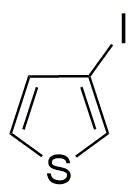3-Iodothiophene is widely utilized in research focused on:
- Organic Electronics: This compound is a key building block in the synthesis of organic semiconductors, which are essential for developing flexible and lightweight electronic devices, such as organic light-emitting diodes (OLEDs) and organic solar cells.
- Pharmaceutical Development: It serves as an intermediate in the synthesis of various pharmaceuticals, particularly those targeting specific biological pathways, enhancing the efficiency of drug discovery processes.
- Material Science: Used in the fabrication of conductive polymers, 3-iodothiophene contributes to the development of advanced materials with applications in sensors and energy storage devices, offering improved performance compared to traditional materials.
- Agrochemicals: This compound is involved in the production of agrochemical products, including pesticides and herbicides, helping to improve crop yields and pest resistance in agriculture.
- Research in Catalysis: It plays a role in catalysis research, particularly in the development of new catalytic systems that can facilitate chemical reactions more efficiently, leading to greener and more sustainable chemical processes.
General Information
Properties
Safety and Regulations
Applications
3-Iodothiophene is widely utilized in research focused on:
- Organic Electronics: This compound is a key building block in the synthesis of organic semiconductors, which are essential for developing flexible and lightweight electronic devices, such as organic light-emitting diodes (OLEDs) and organic solar cells.
- Pharmaceutical Development: It serves as an intermediate in the synthesis of various pharmaceuticals, particularly those targeting specific biological pathways, enhancing the efficiency of drug discovery processes.
- Material Science: Used in the fabrication of conductive polymers, 3-iodothiophene contributes to the development of advanced materials with applications in sensors and energy storage devices, offering improved performance compared to traditional materials.
- Agrochemicals: This compound is involved in the production of agrochemical products, including pesticides and herbicides, helping to improve crop yields and pest resistance in agriculture.
- Research in Catalysis: It plays a role in catalysis research, particularly in the development of new catalytic systems that can facilitate chemical reactions more efficiently, leading to greener and more sustainable chemical processes.
Documents
Safety Data Sheets (SDS)
The SDS provides comprehensive safety information on handling, storage, and disposal of the product.
Product Specification (PS)
The PS provides a comprehensive breakdown of the product’s properties, including chemical composition, physical state, purity, and storage requirements. It also details acceptable quality ranges and the product's intended applications.
Certificates of Analysis (COA)
Search for Certificates of Analysis (COA) by entering the products Lot Number. Lot and Batch Numbers can be found on a product’s label following the words ‘Lot’ or ‘Batch’.
*Catalog Number
*Lot Number
Certificates Of Origin (COO)
This COO confirms the country where the product was manufactured, and also details the materials and components used in it and whether it is derived from natural, synthetic, or other specific sources. This certificate may be required for customs, trade, and regulatory compliance.
*Catalog Number
*Lot Number
Safety Data Sheets (SDS)
The SDS provides comprehensive safety information on handling, storage, and disposal of the product.
DownloadProduct Specification (PS)
The PS provides a comprehensive breakdown of the product’s properties, including chemical composition, physical state, purity, and storage requirements. It also details acceptable quality ranges and the product's intended applications.
DownloadCertificates of Analysis (COA)
Search for Certificates of Analysis (COA) by entering the products Lot Number. Lot and Batch Numbers can be found on a product’s label following the words ‘Lot’ or ‘Batch’.
*Catalog Number
*Lot Number
Certificates Of Origin (COO)
This COO confirms the country where the product was manufactured, and also details the materials and components used in it and whether it is derived from natural, synthetic, or other specific sources. This certificate may be required for customs, trade, and regulatory compliance.


